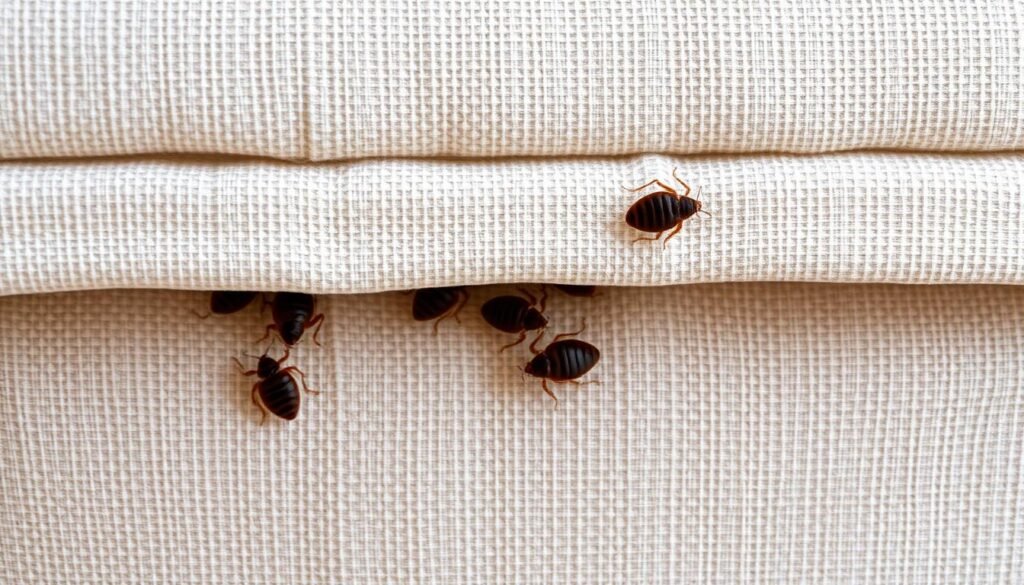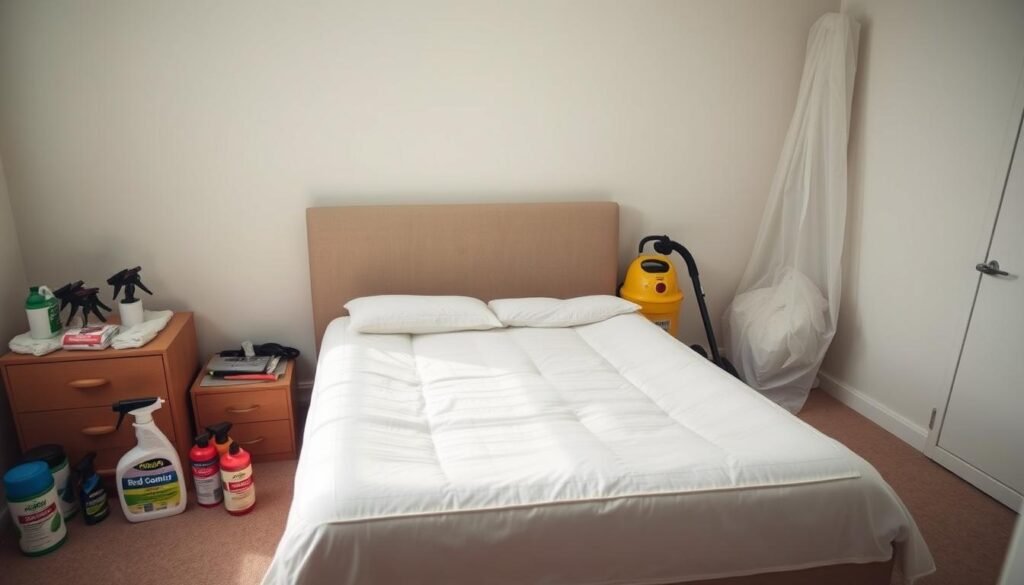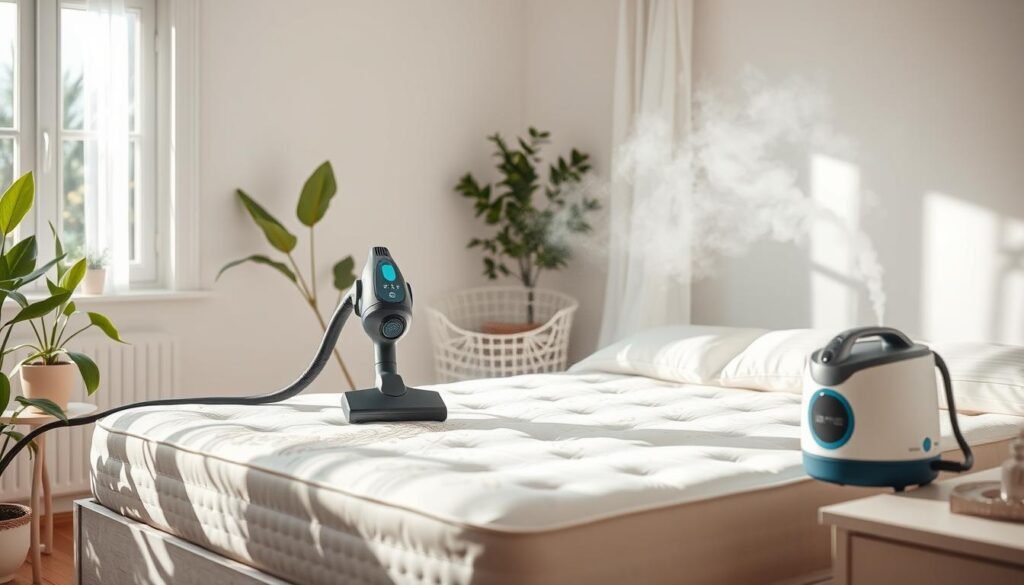Did you know a single pregnant bed bug can produce up to 300 adults and 1,000 eggs in just three months1? These pests can quickly infest mattresses, causing a big problem for homeowners. We’re experts in bed bug control and know how to tackle this issue. In this guide, we’ll share our best methods to remove bed bugs from your mattress and stop them from coming back.
Key Takeaways
- Bed bugs can survive for up to 20 days without feeding and multiply rapidly if not addressed promptly1.
- Thorough inspection and early detection are key to stop a small infestation from growing2.
- Using a mix of chemical and non-chemical methods, like heat treatment, vacuuming, and professional extermination, is often needed for effective removal32.,
- Keeping your bedroom clean, clutter-free, and using mattress encasements can help keep bed bugs away2.
- Regular checks and quick action are essential to avoid bed bugs coming back to your mattress.
Understanding Bed Bug Infestations
Bed bugs are small, flat, and oval-shaped insects that feed on human blood4. They are usually brown but turn reddish after they eat4. Adult bed bugs are about the size of an apple seed, and their eggs are tiny, pale-yellow specks that can be hard to see5. Knowing the signs of bed bug infestations is key to spotting and fixing these problems early.
Common Signs of Bed Bugs
Common signs of bed bug infestations include live bugs, dark fecal spots, shed skins, and clusters of bite marks on the skin4. Bed bugs are great hitchhikers and can easily get into homes in luggage, bags, or furniture5. Once they settle in, they can be tough to control because of their fast life cycle.
Life Cycle and Reproduction
Bed bugs reproduce quickly, with females laying up to 500 eggs in their lifetime4. The eggs hatch in about 10 days, turning into nymphs that feed on blood and shed their skin five times before becoming adults in about six weeks4. This fast growth makes bed bug populations grow quickly, making them hard to get rid of once they infest a home4. Also, bed bugs can live for months without eating, making them even harder to control6.
“Bed bugs are excellent hitchhikers and can be easily transported into homes in luggage, bags, or furniture.”
Identifying and Containing the Infestation
Bed bugs hide in tiny cracks and crevices. To spot them, we need to check places like mattress seams and box spring tufts. We should also look at the headboard, footboard, and bed frame, as well as furniture joints7. A flashlight and magnifying glass can help find signs like live bugs, eggs, shed skins, and fecal stains.
Where to Check for Bed Bugs
Bed bugs love hiding in secure spots. They often hide in mattress and box spring seams, bed frame crevices, and furniture joints8. Look for small blood stains on sheets or pillowcases and dark brown or rust-colored fecal spots8. Tiny, pale yellow skins or eggshells are also signs of bed bugs8.
Preventing Spread to Other Areas
After finding bed bugs, it’s key to stop them from spreading. Seal infested items in plastic bags, vacuum the room well, and wash bedding and clothes at high heat7. Don’t move items from the infested room to other parts of the home9. Keeping the affected areas isolated helps prevent the problem from getting worse.

By taking these steps, we can effectively deal with bed bugs and stop them from spreading789.
Preparing for Bed Bug Treatment
When you face a bed bug problem, getting ready is essential for treatment success. Bed bugs are found everywhere, from hotels to homes, showing they are common in many places10. Their bites can cause allergic reactions, similar to mosquito bites, which can be a health issue for some10.
Attention to detail is key for effective treatment. Experts suggest moving furniture and items 24 inches away from walls in different rooms10. Also, laundry and clothing care are important, with hot water washing and high heat drying to kill bed bugs10.
Pet owners should keep their pets away for at least 12 hours after treatment. Owners with fish in large aquariums can keep them inside if precautions are taken10. People with health issues, like breathing problems or pregnancy, should stay away for 12 hours during treatment10.
Sealing cracks, encasing mattresses, and removing clutter are also important steps. These actions, along with vacuuming, steaming, and washing, help fight the infestation11.
| Pre-Treatment Steps | Importance |
|---|---|
| Move furniture at least 2 feet from walls | Allows for better access and treatment coverage |
| Wash and dry linens, clothing, and bedding on hot setting | Kills bed bugs and eggs through heat |
| Place mattresses and box springs on their side | Exposes more surface area for treatment |
| Remove items that children may put in their mouths | Prevents accidental ingestion of treatment chemicals |
| Vacuum floors and furniture thoroughly | Removes bed bugs and eggs before treatment |
By following these steps, you can greatly improve your chances of getting rid of bed bugs for good11. A thorough preparation, combined with professional exterminators, is key to beating these pests10.

Non-Chemical Bed Bug Removal Methods
There are effective ways to get rid of bed bugs without using harsh chemicals. Heat and cold treatments are both successful in killing bed bugs and their eggs. Heat treatment for bed bugs involves washing and drying bedding and clothes at high temperatures. It also uses steam cleaners on mattresses and furniture to kill the bugs12.
Cold treatment for bed bugs works by packing infested items in plastic bags. Then, they are exposed to extreme cold (below 32°F) for several days13.
Heat and Cold Treatments
Temperatures between 114-115°F can kill bed bugs13. The Cryonite® technology uses -108°F to instantly kill bed bugs13. These methods are very effective, mainly in the early stages of an infestation13.
Vacuuming and Encasements
Vacuuming the mattress, box spring, bed frame, and areas around them can remove visible bed bugs and their eggs13. Also, using bed bug-proof covers on the mattress and box spring traps bugs inside. This leads to their starvation and death13. These non-chemical methods, like vacuuming for bed bugs and using mattress encasements, are strong tools against bed bug infestations13.
Using a mix of these non-chemical bed bug control methods can get rid of bed bugs without harmful chemicals121314.

How to Remove Bed Bugs from Mattress
If simple methods don’t work, you might need to use insecticides and pesticides. Bed bugs can be tough to get rid of because some have become resistant to certain chemicals15. So, using both chemical and non-chemical treatments might be the best way to get rid of them all15.
Insecticides and Pesticides
Products like pyrethrins, pyrethroids, and neonicotinoids, which are EPA-approved, can kill bed bugs15. But, it’s important to follow the instructions carefully and protect people and pets15.
Professional Extermination Services
For really bad bed bug problems, getting a professional exterminator might be your best bet. Pest control companies use special treatments and techniques, like whole-room heat treatments, that you can’t do at home16. They usually need to visit multiple times to make sure all bed bugs are gone, which is often more effective than trying to do it yourself, even in tricky spots15.
When you pick a pest control company, make sure they’re good and have lots of experience. They can figure out how bad the problem is, come up with a plan just for you, and make sure bed bugs are gone from your mattress and around it16.
Remember, getting rid of bed bugs can take a few months15. You need to stay alert and keep working hard to win the battle16.
Evaluating Treatment Effectiveness
After a successful bed bug treatment, it’s important to keep watching the area for signs of bed bugs17. Bed bugs have become a big problem in cities over the last ten years. Keeping an eye out is essential to make sure they are gone for good18.
Monitoring is a key part of managing pests. It involves looking closely and using tools like magnifying glasses and flashlights. Even bed bug-sniffing dogs can spot them with up to 97% accuracy18.
There are different ways to check for bed bugs. Passive monitors offer a cozy spot for them, while active ones attract them. New tech like infrared cameras and pheromone traps also help find them early18. Keeping your space tidy also helps find and get rid of bed bugs more easily18.
If you see signs of bed bugs again, act fast17. Professional pest control is often better than trying to do it yourself. They can give a detailed plan to get rid of all bed bugs17.
By staying alert and taking steps ahead of time, you can keep bed bugs away for good17.
“Maintaining vigilance and taking proactive measures is the key to ensuring the long-term success of bed bug treatment.”
Preventing Future Bed Bug Problems
To keep your home bed bug-free, stay alert and clean regularly. Vacuuming with strong suction can remove bed bugs and eggs from hidden spots19. Also, wash bedding and clothes at high heat for at least 90 minutes to kill any bugs19.
Sealing cracks and crevices stops bed bugs from getting in. Metal bed frames might be less attractive to them than wooden ones19. Taking apart bed frames and checking them can catch infestations early19.
Travel Precautions
Travel often brings bed bugs into homes. They can hide in luggage and personal items. Always check hotel rooms for bed bugs before you unpack20. Keep your luggage off the bed and use covers to stop bed bugs from hitching a ride home19. Washing and drying clothes on high heat after traveling can also get rid of bed bugs19.
“Effective control of a bed bug infestation relies on the thoroughness of treatment, addressing all infested areas to prevent reinfestation.”21
Keep your home clean and clutter-free. Watch for bed bug entry points. And take travel precautions to avoid bringing bed bugs home192120.
Conclusion
To get rid of bed bugs from a mattress, we need a detailed plan. Knowing the signs, like bed bugs being 1-7 millimeters long22, helps us find and remove them. This way, we can make our beds safe and comfy again.
Using heat, cold, or chemicals like pyrethrins22 can help kill bed bugs. It’s also important to stay alert and clean regularly. Checking beds and furniture when traveling and inspecting secondhand items22 helps keep bed bugs away.
Bed bugs are a big problem in the US, with 1 in 5 homes affected in the last year23. They can live up to a year without eating and grow fast in mattresses2423. So, acting fast and using the right methods is key to keeping our homes safe and healthy.
FAQ
What are the common signs of a bed bug infestation?
How do bed bugs reproduce and spread quickly?
Where do bed bugs typically hide?
What are the important steps to prepare for bed bug treatment?
What are some non-chemical methods for removing bed bugs?
When should I consider using insecticides or hiring a professional exterminator?
What steps should I take to prevent future bed bug infestations?
Source Links
- How to Get Rid of Bed Bugs in a Mattress – Amerisleep – https://amerisleep.com/blog/get-rid-of-bed-bugs-in-a-mattress/
- 6 Ways on How to Kill Bed Bugs in Your Mattress – https://www.ecosa.com.au/blog/post/best-ways-on-how-to-kill-bed-bugs-in-your-mattress.html?srsltid=AfmBOoqCm5I971BkLajE6DUUhgX5x-qcsA3ExPrf4uUXf2e7A-NPljLo
- How to Get Rid of Bedbugs: A Step-by-Step Guide – https://www.healthline.com/health/healthy-home-guide/how-to-get-rid-of-bed-bugs
- Bedbugs – Signs of an Infestation and How to Get Rid of Bedbugs – https://www.webmd.com/skin-problems-and-treatments/bedbugs-infestation
- Bed Bugs – What They Are and How to Control Them – https://www.health.ny.gov/environmental/pests/bedbugs.htm
- Bed Bugs – https://dph.illinois.gov/topics-services/environmental-health-protection/structural-pest-control/bed-bugs.html
- How to Check Your Mattress for Bed Bugs | Sleep Foundation – https://www.sleepfoundation.org/mattress-information/how-to-check-your-mattress-for-bed-bugs
- How to Remove Bed Bugs from a Mattress: 5 Essential Tips – Truly Blog – https://trulynolenindia.com/blog/en/how-to-remove-bed-bugs-from-a-mattress
- How to Get Rid of Bedbugs (& What Not to Do) – https://zomasleep.com/blog/how-to-get-rid-of-bed-bugs
- ENGLISH.qxd – https://www.gov.mb.ca/asset_library/en/bedbugs/bed_bug_treatment_guide.pdf
- Bed Bugs | Informational Guide to Bed Bugs | Purdue | Monitoring | Control | Treatment | IPM |Prevention | Biology – https://extension.entm.purdue.edu/bedbugs/treatment.php
- 5 Natural Bed Bug Solutions | Bed Bug Exterminator – https://www.pestsolutions.ca/5-natural-bed-bug-solutions/
- Layout 1 – https://www.vdacs.virginia.gov/pdf/bb-nonchemical1.pdf
- 9 Non-Toxic Ways to Get Rid of Bed Bugs (& Avoid Them) – https://wellnessmama.com/natural-home/bed-bugs/
- How to Get Rid of Bed Bugs in a Mattress in 5 Steps – https://www.bobvila.com/articles/how-to-get-rid-of-bed-bugs-in-a-mattress/
- How To Get Bed Bugs Out of a Mattress: A Guide | Leesa – https://www.leesa.com/article/how-to-get-bed-bugs-out-of-mattress?srsltid=AfmBOoo42BlNxcpEyP5MZUqxPqW6ybWjxdSJ2zLmLiMSx6Zgm72Wxj_X
- Cost-Effective and Money-Wasting Bed Bug Control Methods (Rutgers NJAES) – https://njaes.rutgers.edu/fs1251/
- Battling Bed Bugs: Unveiling the Most Effective Treatment Methods – https://staysafe.org/pest-control/what-are-the-best-bed-bug-treatment-methods/
- How To Get Bed Bugs Out of a Mattress: A Guide | Leesa – https://www.leesa.com/article/how-to-get-bed-bugs-out-of-mattress?srsltid=AfmBOopAz7B4viicwr4IjF6ZdGzAjM0ppVuQS7laYkuBhSI5VetzFs6-
- How to Get Rid of Bed Bugs – https://www.homedepot.com/c/ab/how-to-get-rid-of-bed-bugs/9ba683603be9fa5395fab905e905e0c
- Bed bug prevention and control in the home – https://extension.umn.edu/bed-bugs/bed-bug-prevention-and-control-home
- How to get rid of bedbugs: Natural, chemicals, and pest control – https://www.medicalnewstoday.com/articles/298185
- How to Get Rid of Bed Bugs in a Mattress – eachnight – https://eachnight.com/mattress-resources/how-to-get-rid-of-bed-bugs-in-a-mattress/
- How To Remove Bed Bugs From A Mattress – https://www.heveya.sg/blogs/articles/103741958-how-to-remove-bed-bugs-from-a-mattress?srsltid=AfmBOoozPaUrho48pNJcztonHxFwY4lhHJsiblmtTI7rLp07pZ_WV8vj
